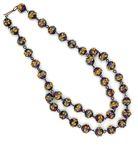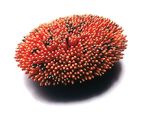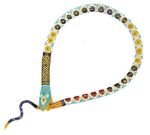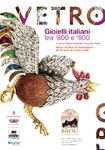Grazie al tributo storico e artistico - Museo del Bijou
←
→
Trascrizione del contenuto della pagina
Se il tuo browser non visualizza correttamente la pagina, ti preghiamo di leggere il contenuto della pagina quaggiù
G
razie al tributo storico e artistico
dell’Anno Internazionale del Vetro,
acquista uno speciale significato la
mostra “Vetro. Gioielli italiani tra ‘800 e ‘900”,
progettata dal Museo del Bijou di Casalmaggiore
(CR), nel periodo che va dal 23 aprile al 9 ottobre
2022. Sottolineando il ruolo tecnologico, scientifico,
economico, ambientale, storico e artistico del vetro nella nostra
società, se ne evidenzia nel contempo il potenziale contributo
per affrontare le sfide dello sviluppo sostenibile e delle società
inclusive. L’evoluzione dello stile, del costume e della società italiana
negli ultimi due secoli, viene con efficacia interpretato dalla
selezione di oltre 300 esemplari tra gioielli d’autore, oggetti,
disegni, foto e documenti d’epoca, presenti in mostra. Il vetro, nella
Spilla “Anemone Rosso”, con conterie veneziane, in oro e argento ossidato.
Barbara Paganin, Venezia, 1996.
“Red Anemone” brooch with Venetian glass beads, in gold and oxidised silver.
Barbara Paganin, Venice, 1996.
93century, bracelets in Decò style of murrine millefiori, jewels in Roman micro mosaic made for the Grand Tour, large
multi-strand colliers and collarettes made with miniscule glass beads to match with the tailored cocktail dresses of
the 1960s. Highly representative of the theme handled are also the numerous bouquet earrings of the 1950s, the
bijoux of hippies inspired by the native Americans, the large crystals of the 1980s, as well as several experimental
creations of great designers and artists at the turn of the millennium. Following the process of industrialisation,
between 1800 and 1900, glass diversified its identity and functions, into the production of jewels: its use is
applied to both sophisticated luxury jewels, in products of the highest craftsmanship, object of technical and artistic
experimentation, and in low-cost jewels for the public at large. “In the early 20th century, the glass bead becomes
an essential accessory in the elegant and seductive fashion of the modern woman”, says Augusto Panini one of
In alto: spilla a forma di galletto, in vetro avventurina, oro giallo, oro bianco, diamanti, gemme sintetiche. Italia, 1940 -1950.
Sopra: pendenti con intarsio di vetro murrino e argento. Franco De Cal, Venezia, anni ‘80 del XX secolo.
Top: cockerel-shaped brooch, in aventurine glass, yellow gold, white gold, diamonds, synthetic gems. Italy, 1940 -1950.
Above: pendants with murrino glass inlay and silver. Franco De Cal, Venice, 1980s.
94sua multiforme varietà, si esprime al suo meglio in una serie di preziosi manufatti: lunghi e
colorati sautoir di inizio secolo, bracciali in stile Decò di murrine millefiori, gioielli in micro mosaico
romano realizzati per il Grand Tour, grandi collier multifilo e collarette realizzate con minuscole conterie
da abbinare agli abiti da cocktail sartoriali degli anni ‘60. Molto rappresentativi del tema trattato sono anche
i numerosi orecchini a bouquet degli anni ‘50, i bijoux dei figli dei fiori ispirati ai nativi americani, i grandi cristalli
degli anni ‘80, come pure alcune creazioni sperimentali dei grandi designer e artisti di fine millennio. A seguito
del processo di industrializzazione, tra ‘800 e ‘900, il vetro ha diversificato la sua identità e le sue funzioni, nella
realizzazione di gioielli; la sua utilizzazione si applica sia a ricercati monili di lusso, in veste di prodotto di altissimo
artigianato, oggetto di sperimentazione tecnica e artistica, che a gioielli di basso costo, per il grande pubblico.
Al centro: collane con piastre di vetro a mosaico con motivi a forma di occhi. Ercole Moretti, Murano (VE), 1968.
A destra: spilla, a cammeo di pasta di vetro opaco stampata, in oro. Italia/Francia/Germania, circa 1900.
At the centre: necklaces with mosaic glass plates with eye-shaped motifs. Ercole Moretti, Murano (VE), 1968.
Right: brooch, stamped opaque glass paste cameo, in gold. Italy/France/Germany about 1900.
95the curators of the exhibition “and reappropriates herself of the highly charming role held over the last centuries,
from Cleopatra to Elisabetta Gonzaga”. Bianca Cappello, also curator of the exhibition, adds: “From prehistory
to our day, the glass jewel has been able to move in step with the language, genius and aesthetics of society
always succeeding in expressing and showing its characteristics”. “The glass in the jewel is ‘fragile and
unbreakable’ at the same time, it is a material that tells of the high level attainable with craftsmanship and which,
over the last two centuries, has become the protagonist in jewels of the Fashion System, as well as in the Researched
and Design Jewel”.
In alto: collana-bracciale a forma di serpente, con conterie intessute a crochet, Italia/Repubblica Ceca, anni ’20 -’30 del XX secolo; al
centro della collana: spilla in metallo dorato stampato e cristalli di vetro. Casalmaggiore (CR), anni ‘30 del XX secolo. Sopra: collane e
bracciali, in perle di vetro colorato incamiciato in argento, ottone. Venezia, metà del XIX secolo.
Top: necklace-bracelet in the shape of a snake, with crochet woven glass beads, Italy/Czech Republic, 1920s - 1930s; at the centre
of the necklace: stamped gold-plated metal brooch and glass crystals. Casalmaggiore (CR), 1930s. Above: necklaces and bracelets,
in coloured glass beads plated in silver, brass. Venice, mid -19th century.
96“Agli inizi del XX secolo la perla di
vetro diventa accessorio indispensabile
nell’abbigliamento elegante e seducente
della donna moderna”, afferma Augusto
Panini, uno dei curatori della mostra, “e si
riappropria di quel fascinosissimo ruolo avuto
nel corso dei secoli, da Cleopatra a Elisabetta
Gonzaga”. Bianca Cappello, anch’essa curatrice
della mostra, aggiunge: “Dalla preistoria ad oggi,
il gioiello di vetro è stato capace di muoversi al passo
con il linguaggio, l’ingegno e l’estetica della società
riuscendo sempre a raccontarla e a mostrarne le
caratteristiche” . “Il vetro nel gioiello è ‘fragile e indistruttibile’
al tempo stesso, è un materiale che racconta l’altissimo livello
raggiungibile con l’artigianato artistico e che, negli ultimi due
secoli, è entrato da protagonista nei gioielli del Sistema Moda,
così come nel Gioiello di Ricerca e in quello di Design”.
Collana, in perle di vetro a lume, con motivi floreali, montate in filo
di metallo. Venezia, XIX secolo.
Necklace, lampwork glass beads, with floral motifs, mounted on a
metal wire. Venice, 19th century.
L a realizzazione della splendida mostra è stata resa possibile
grazie all’impegno suoi curatori: Bianca Cappello, storica e
critica del gioiello, docente, coordinatore e curatore di
conferenze e seminari sulla storia e la cultura del gioiello, e
Augusto Panini, tra i massimi esperti e collezionisti di perle di
vetro mediorientali e veneziane, consulente del Museo del Vetro
di Murano, Fondazione Musei Civici di Venezia.
T he magnificent exhibition has been made possible by the
commitment of its curators: Bianca Cappello, historian and
jewellery critic, professor, coordinator and curator of
conferences and seminars on the history and culture of the jewel,
and Augusto Panini, one of the leading experts and collectors
of Middle Eastern and Venetian glass beads, consultant of the
Murano Glass Museum, Fondazione Musei Civici of Venice.
www.museodelbijou.it
97Puoi anche leggere



























































